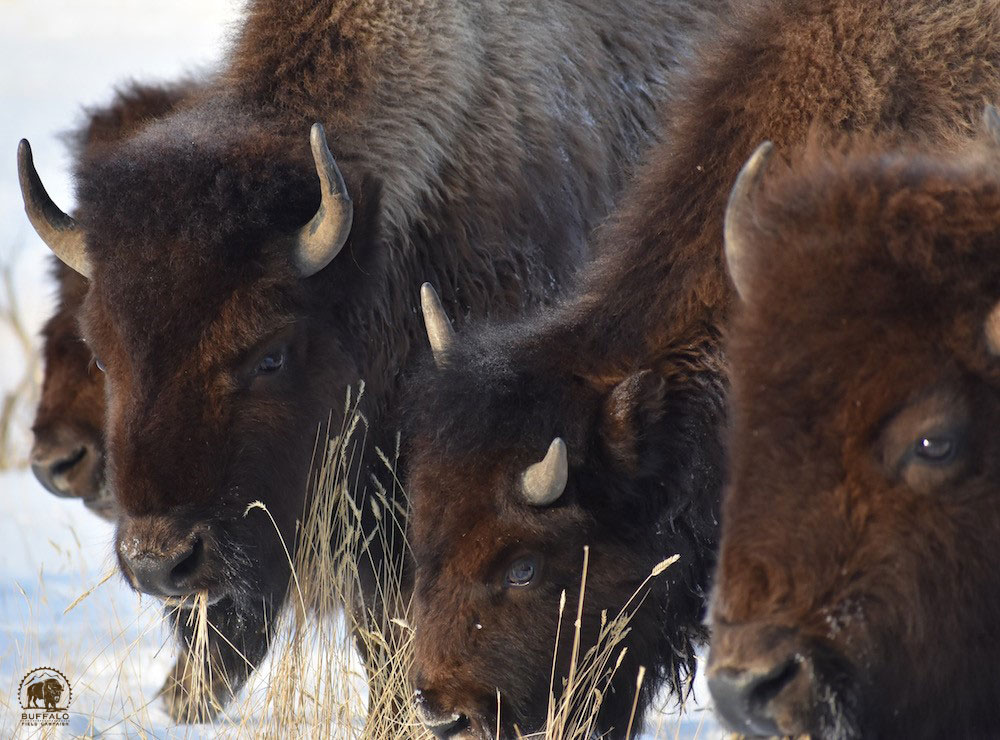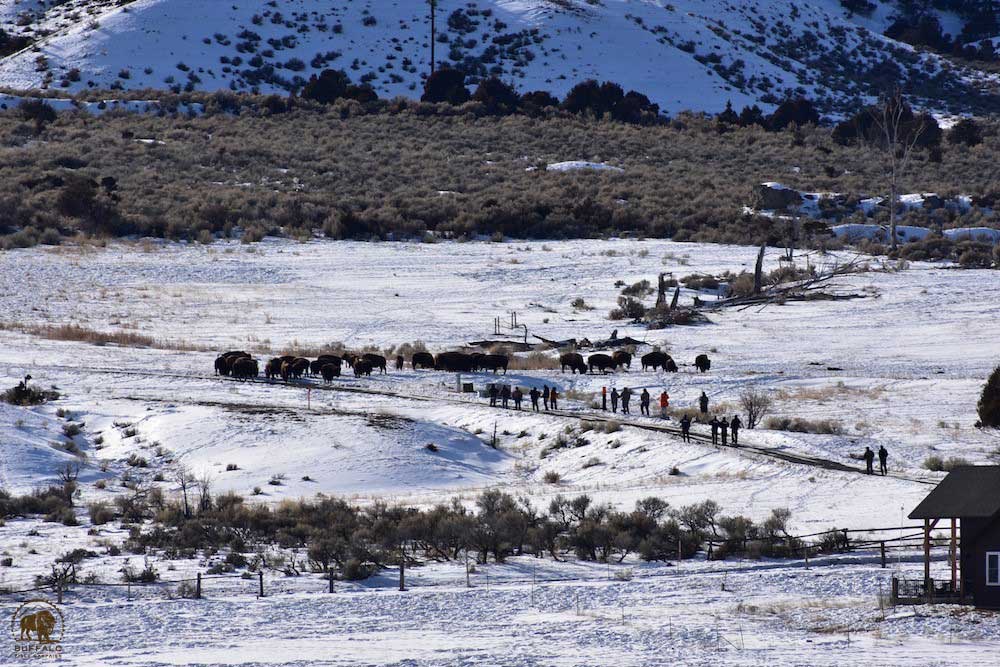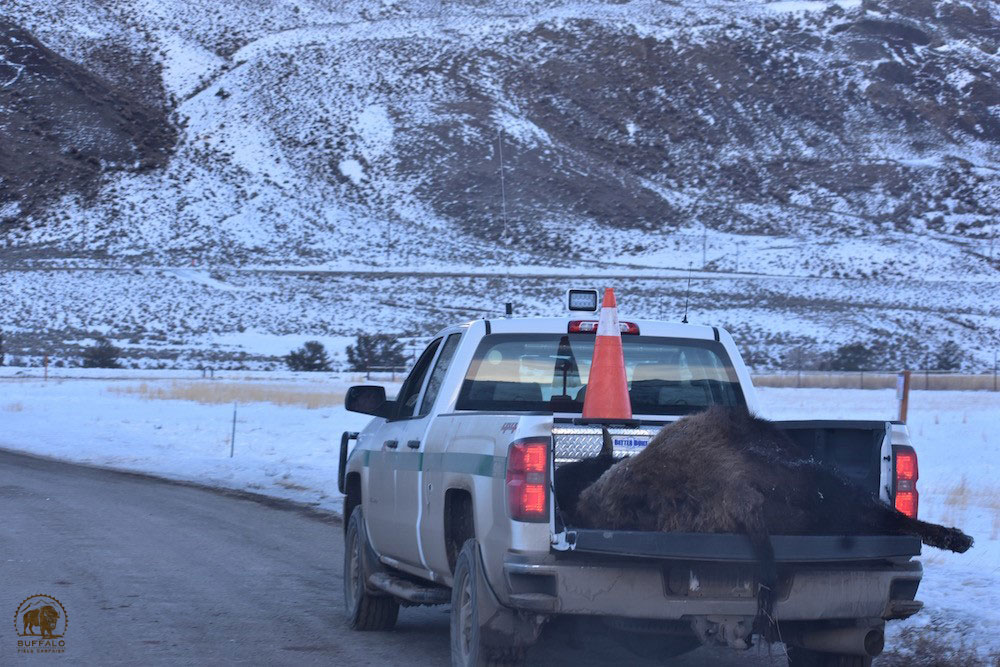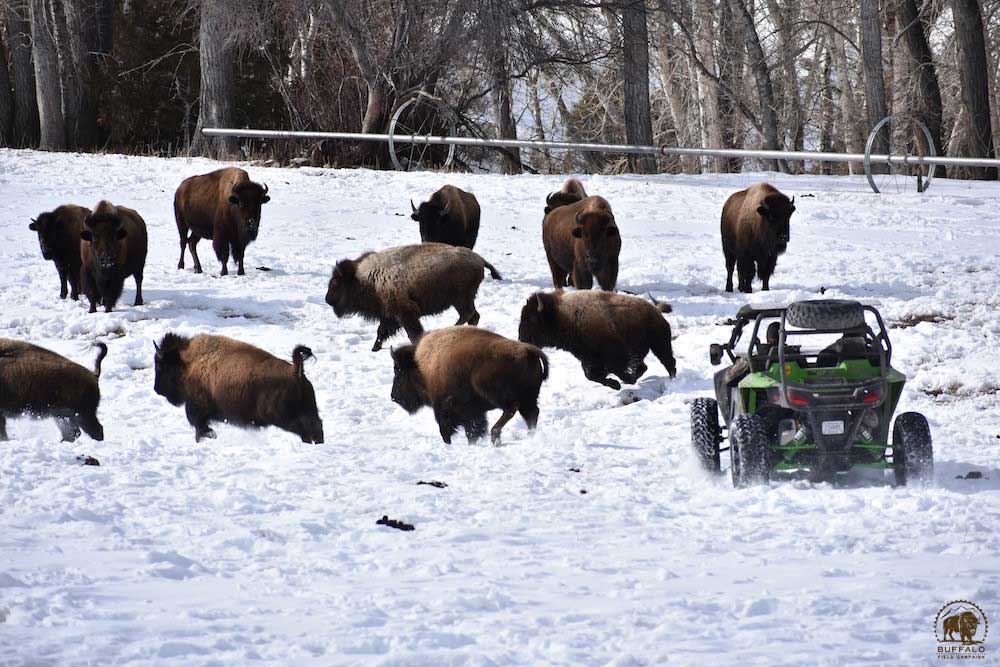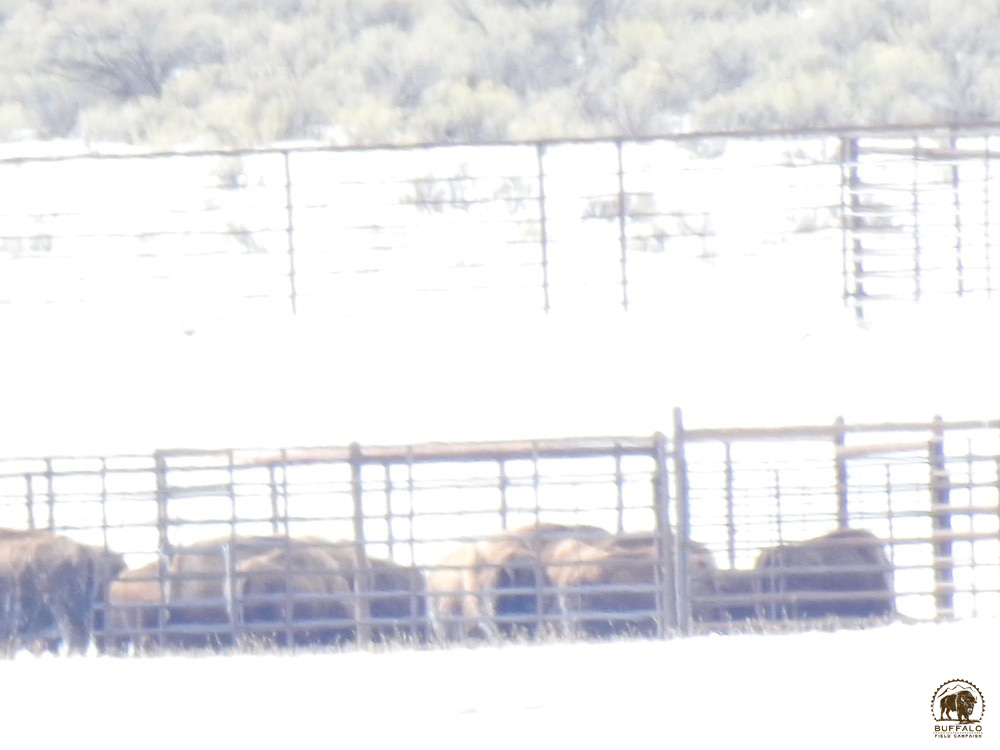Our beautiful friends and relatives, the buffalo, moving into the Gardiner Basin. Photo by Stephany Seay, Buffalo Field Campaign.
We haven’t had too much to report from the field yet this season, but that has now changed. After months of inactivity due to a relatively mild winter, our last snow event triggered wild buffalo migration, bringing them out of deeper snows in Yellowstone’s higher elevation habitat, to easier grazing in the Gardiner Basin. Our Gardiner camp is now open and in full swing. Gardiner patrols are a full week long, and consist of two to four volunteers doing both morning and afternoon shifts, monitoring the huge expanse of one of North America’s largest wildlife migration corridors. Gardiner is rich with herds of elk, mule deer, bighorn sheep, pronghorn antelope, as well as wolves, coyotes, eagles, and other amazing wildlife. Now, hundreds of wild, migratory buffalo have made their way into the Gardiner Basin, and while we are so thrilled once again to be in their presence after such a long absence, they are being met with all kinds of challenges.
We hope it goes without saying, but let it be said that BFC sincerely appreciates, respects, supports, and honors treaty rights and Tribal participation with the buffalo, and we know we have to come together — being naturally the strongest allies for the buffalo — to combat the real culprit, which is the State of Montana and the Interagency Bison Management Plan, who continue to try and divide us as they attempt to prevent these sacred beings from restoring themselves on their native habitat.
Beattie Gulch. A hunting landscape that is a recipe for disaster. The buffalo population must be allowed to flourish, and spread out on a much larger landscape. Photo by Stephany Seay, Buffalo Field Campaign.
Hunting has begun in earnest in Gardiner, mostly within the infamous “killing box" of Beattie Gulch, a very narrow migration corridor, used mainly by matriarch-lead family groups, which takes them out of the relative shelter of Yellowstone National Park into areas where they can be taken by hunters. We say “relative shelter” because just a mile south of Beattie Gulch, inside the Park, is Yellowstone’s nefarious Stephens Creek buffalo trap. As of this writing, forty buffalo have been taken by hunters, thirty-five of these have been killed since Sunday. Hunters have waited months for migration to begin, and now that it has, they are wasting no time trying to fill their tags.
An unnecessary casualty of a hunt on a landscape that is much too small, of a population that must be allowed to grow and restore themselves. Photo by Stephany Seay, Buffalo Field Campaign.
On Sunday, hunters took 19 buffalo — taking an entire family group of 15, then later another four — then on Monday, another nine were taken, and on Tuesday ten more. Tuesday’s event was especially tragic because multiple hunters approached a small herd, firing into them eager to fill their tags: consequently, in addition to the ten who were killed on the spot, five other buffalo were shot, injured, and fled into the Park. Of these five, two died inside the Park, one more had to be put out of her misery by a Park Ranger, and the two others who were hit had relatively minor injuries so are still walking around, though wounded. Buffalo are very tough animals, and it is amazing what they are able to survive, though it pains us greatly to know they have been injured in such a way. While each individual is responsible for their actions, it is critical to point out that this hunt and the minimal landscape it is carried out upon, has been set up by the State of Montana and other bison management agencies to result in exactly the things we continue to see taking place year after year. The hunt as it now is, is being used to prevent wild buffalo from restoring themselves on their native habitat. Buffalo are granted very little habitat outside Yellowstone’s boundaries, and the landscape they are able to access is a patchwork of both public and private land, where hunting rules and opportunities are very different. This sets both hunters and buffalo up for unnecessary failure, a disaster crafted by Montana and the Interagency Bison Management Plan. Hunters are driven into competition with each other, and also are pressured into feeling a race against Yellowstone’s buffalo trap. All of this happening to a buffalo population — the last of its kind — that can not sustain such hunting pressure, and certainly not capture for slaughter. There is a simple solution which Montana will soon have to embrace: many more buffalo on a much larger landscape; respect wild buffalo like wild elk in Montana: let them roam!
A very aggressive hazing operation conducted by two intolerant locals. Across the river, hunters waited to the north, while Yellowstone’s trap gets prepared to the south. Photo by Stephany Seay, Buffalo Field Campaign.
We also witnessed an event we haven’t experienced in many years in Gardiner: a hazing operation. But, this one was conducted by a couple of private citizens, rather than government agencies. There were about 40-200 buffalo spending peaceful time grazing on a private pasture, which is under conservation easement. There is also a very small band of horses and mules who use this pasture, and the buffalo and equines were getting along just fine. But, apparently a couple locals didn’t like it. As we were monitoring the Beattie Gulch area, we were parked right by this pasture with the buffalo, and suddenly a dune-type buggy races into the snowy field and proceeds to very aggressively haze the gentle giants off of the pasture, across the Yellowstone River, and into Yellowstone National Park, where they started heading towards Beattie Gulch. As this was happening, a smaller group of buffalo were moving into Beattie Gulch where hunters waited for them. That’s when the fifteen buffalo mentioned above were shot. As the survivors of this group bolted back into Yellowstone, they met up with the 200, who did an about face and joined them moving further into Yellowstone.
Buffalo clearly within the fence line of Yellowstone’s Stephens Creek buffalo trap. Yellowstone states they have not yet begun capture operations. We are monitoring the situation very closely, and we will have better photos for you soon — we were trying out a new camera with a strong zoom lens. Photo by Greg Marin, Buffalo Field Campaign.
The following morning, Wednesday, there were about 250 buffalo scattered between the area around Yellowstone’s Stephens Creek trap and lands just south of Beattie Gulch. Many hunters were waiting at Beattie Gulch for the buffalo to approach, which we were certain they would do as well. There was one young female who seemed to be in a real hurry to get to Beattie Gulch, but the others moved slowly. The little girl kept looking back, waiting, but the other stopped to graze. She stood out for a long time, seemingly pleading and impatient. Why did she want to go to Beattie Gulch so badly? Had she lost a relative there the day before? Did she know something else? Reluctantly, she rejoined the herd. Then, as the morning went on, something strange happened. These buffalo who were closest to Beattie Gulch crossed the Yellowstone River and came back on to the pasture they had been hazed from the day before. They were there for just a short while, when all kinds of law enforcement, plus a local outfitter, showed up and were watching them. Two small spotter planes were also seen flying around this area. Out of nowhere something spooked the buffalo or triggered them into a bit of a stampede. Seemingly for no reason, they bolted off the pasture, swam across the river, back into the Park, danced around for a while, then started making a bee-line towards the trap. That same young female tried coaxing them in the opposite direction, towards Beattie Gulch. Again, her pleading fell on deaf ears. Not long after, we witnessed many of the buffalo in this area heading straight for the open gate of the trap’s outer catch pen. In they went, one after another as caught in a spell. Were they being baited into the trap? Did that little buffalo know this was about to happen? Why did they suddenly head there? Have federal and state agencies expanded on the methods used to snare wild bison? It was interesting to see those buffalo abruptly change course and walk straight toward the Stephen's Creek Trap. Seen feeding near the outer gates, then moving inside with purpose, the buffalo seemed to be attracted by something located there. Responding to our inquiries about capture this morning, Yellowstone officials reached out denying any current activity to corral bison, though we have documentation of them inside the trap’s fence line. We are monitoring the situation very closely, and make no mistake, whether it begins today or next week, Yellowstone certainly intends to capture (for slaughter and domestication) hundreds of the country’s last wild, migratory buffalo — a sacred, keystone species who warrants federal protection, not persecution.
TAKE ACTION!
Please contact:
Yellowstone Superintendent Cameron (Cam) Sholly
Yellowstone National Park
P.O. Box 168
Yellowstone National Park, WY 82190-0168
Phone: (307) 344-2002
Email:
WILD IS THE WAY ~ ROAM FREE!

